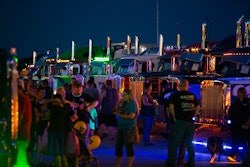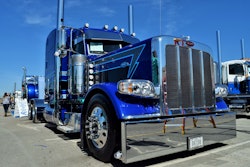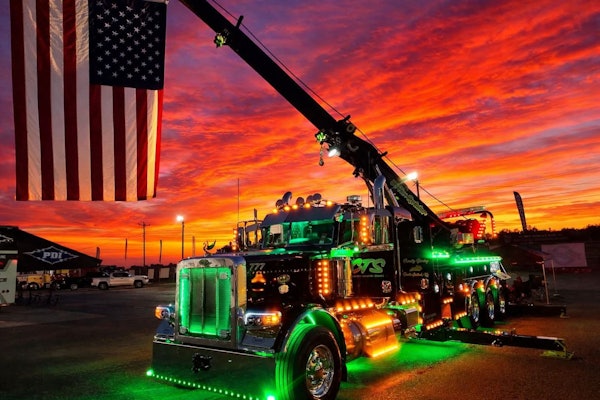James “J.D.” Green is a heavy equipment operator for the Gerken Asphalt and Materials company, based in Napoleon, Ohio. He reached out a week ago looking for an old story in Overdrive whose publication date he wasn’t certain of, just that it featured a pristine blue and white Autocar with a gold stripe and overall paint design he’d come to know quite well in subsequent years. When he was a kid reading his grandfather Jim Frazier’s Overdrive copies, he brought this particular picture home to his father, owner-operator Harland “Harley” Green, who would end up in summer 1981 basing a new paint design for his own 1971 Autocar on that very truck. After a little digging through the Tuscaloosa office archives, my colleague Holley Young found the original story.
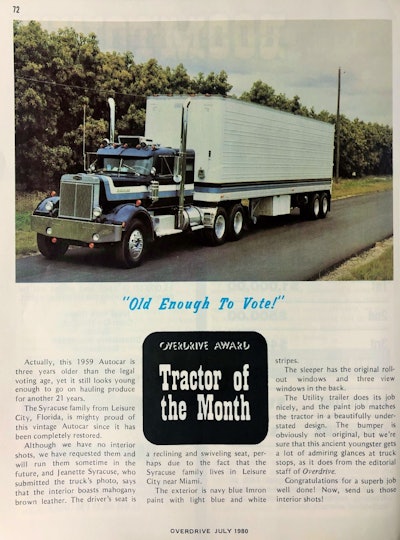 Green was off by 10 years in his recollection of the year of this 1959 Autocar — he’d recalled it as a 1969, yet the then-Florida-based rig is no doubt exactly the one he was thinking of when he wrote in to see whether we might find it.
Green was off by 10 years in his recollection of the year of this 1959 Autocar — he’d recalled it as a 1969, yet the then-Florida-based rig is no doubt exactly the one he was thinking of when he wrote in to see whether we might find it.“That is most definitely the truck that gave us the inspiration for my dad’s 1971,” Green says. Owner-operator Frazier of Fremont, Ohio, had purchased the Autocar brand-new as a glider “from the White dealership in Fremont at the time.” Harley Green “wrenched for him” at the time, when James Green was a mere toddler. “They drilled all the holes in the frame and added Rockwell 4:11 rears.” The unit featured an 855 series Cummins, 350 horse, says Green, and a four-by-four two-stick transmission.

“She was plain jane, no power steering, no AC,” Green says. “Just a work truck. Dad bought it from my grandpa and had it for a few years” before making moves toward repainting the truck. Green was about 10 years old when he saw the story above.
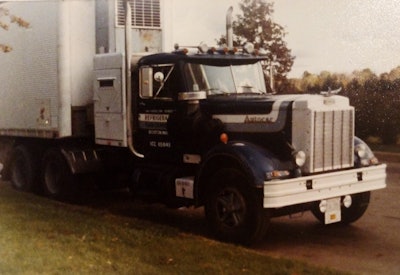 The results, after the cab was painted in July of 1981. Says Green, “My dad owned and drove it to about 1986, when he sold it. I have no history beyond him selling the truck other than to tell you I was greatly disappointed.”
The results, after the cab was painted in July of 1981. Says Green, “My dad owned and drove it to about 1986, when he sold it. I have no history beyond him selling the truck other than to tell you I was greatly disappointed.”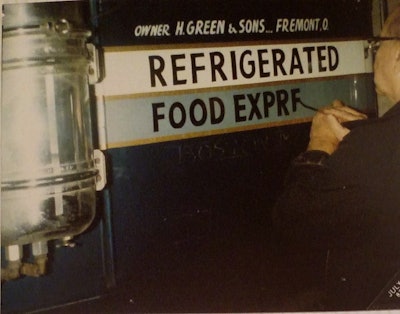 Another scene from the painting. Find some other shots of the 1971 Autocar in old photo-book stills at the bottom of this post.
Another scene from the painting. Find some other shots of the 1971 Autocar in old photo-book stills at the bottom of this post.There’s a story about yet another truck in the family, though, says Green, that conjured all of these memories in him to begin with.
Frazier, Green’s maternal grandfather, was “driving a small truck before he went to World War II,” Green says. “He served and came back and he and his dad, my great-grandfather, both had Diamond Ts in the 1950s and hauled steel together. When the union workers started striking and the steel factories closing, they went from steel to food products in reefers. They hauled meat and produce and so on.”
Frazier absolutely “loved Diamond Ts,” Green says. He “had them most of his entire career. In 1967 he bought his last one” just before Diamond T shuttered. “He ran that truck until 1973. In the meantime, Diamond Reo was put together from Diamond T and the Reo truck line and in 1973 he bought a brand-new Diamond Reo in Indianapolis.” Frazier would drive that truck through 1994, when he passed. The 1974-model Diamond Reo spent the next 25 years “in the garage” on his grandmother’s property, Green says. “Occasionally I’d start it, drive it around and keep everything moving on it. My grandma passed away in January of this year. My mom and her sister had to make some decisions on what to do with the property and the truck and the possessions.”
Along the way, the family “heard about the Iowa 80 Trucking Museum in Walcott,” Green says. The weekend after Easter, Green and family drove out to Iowa to pay the ’74 a visit in her new home. Pictures of the classic follow.
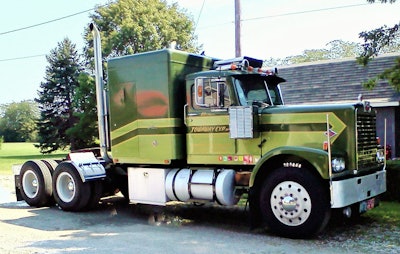 In order to transport the unit to Walcott, the twin five-inch stacks had to be cut to top-of-sleeper level, Green notes. This picture, obviously, is before the removal.
In order to transport the unit to Walcott, the twin five-inch stacks had to be cut to top-of-sleeper level, Green notes. This picture, obviously, is before the removal.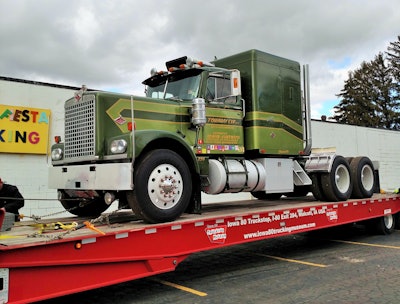 The ’74’s engine is an 855 Cummins at 350 horses with a 13-speed RTO9513 transmission. From the factory it came with Eaton rears at 4:33 ratio. “About 1990 he bumped it up to 4:11,” says Green.
The ’74’s engine is an 855 Cummins at 350 horses with a 13-speed RTO9513 transmission. From the factory it came with Eaton rears at 4:33 ratio. “About 1990 he bumped it up to 4:11,” says Green.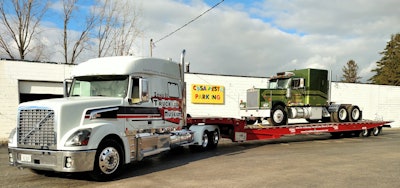 The ’74 model had initially featured “a 36-inch crawl bunk,” Green adds. His grandfather along the way, however, “bumped it up to a 65-inch walk-in sleeper.”
The ’74 model had initially featured “a 36-inch crawl bunk,” Green adds. His grandfather along the way, however, “bumped it up to a 65-inch walk-in sleeper.”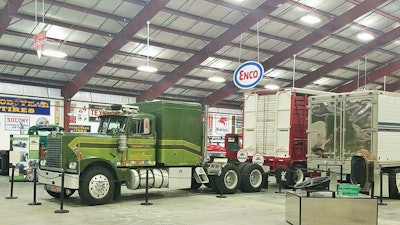 The stacks remained stubbed off when Green visited the rig’s new home in May, though Iowa 80 reps assured him they had plenty chrome around for the eventual replacements.
The stacks remained stubbed off when Green visited the rig’s new home in May, though Iowa 80 reps assured him they had plenty chrome around for the eventual replacements.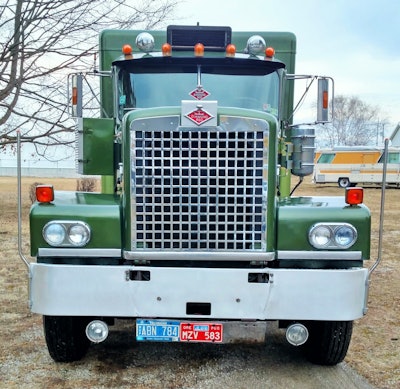 View of the rig from the front.
View of the rig from the front.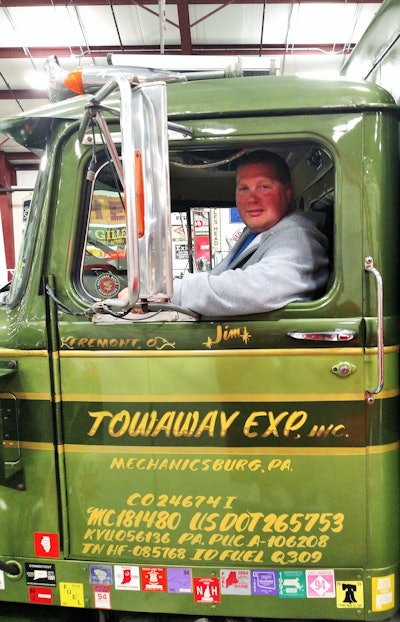 James “J.D.” Green himself, behind the wheel of the ’74. His mother “insisted I have my picture taken in the cab of the truck because no one thought to take my picture as I was driving the truck up onto the lowboy” as the ’74 made what is likely its final haul.
James “J.D.” Green himself, behind the wheel of the ’74. His mother “insisted I have my picture taken in the cab of the truck because no one thought to take my picture as I was driving the truck up onto the lowboy” as the ’74 made what is likely its final haul.Thanks to Green for his memories, here, a window into a past that I’m sure will spark some of your own. If you’ve got a tip about where Harley Green’s 1971 Autocar is these days, too, send it this way.
James “J.D.” Green fondly recalls his childhood and notes that “Grandpa, Dad, and now Grandma Eileen are at rest and home with the Lord.” Green’s father, Harley, passed five years ago Easter. Here’s a couple more windows on that truck, shared from Marie’s (Harley’s wife’s) albums.
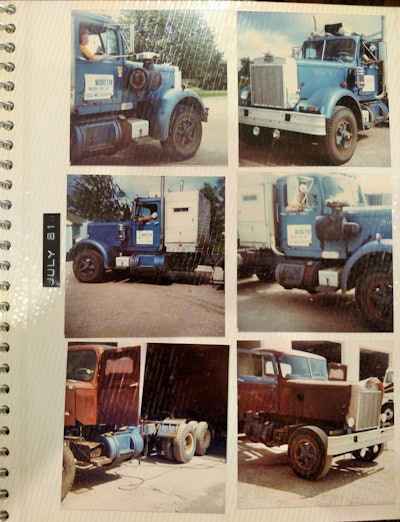 Before the rig was repainted.
Before the rig was repainted.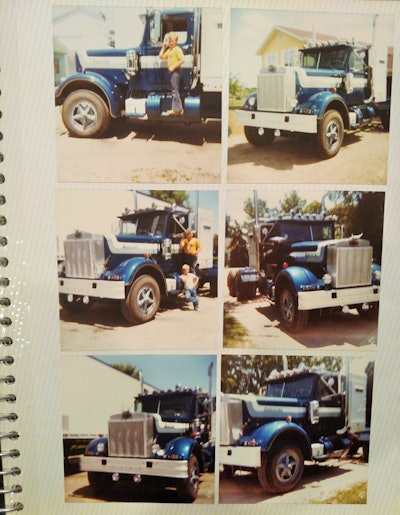 After repainting.
After repainting.
